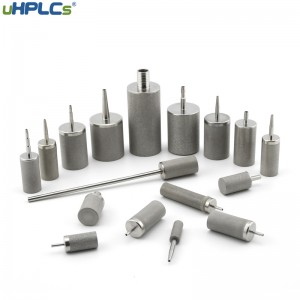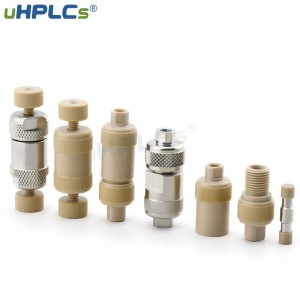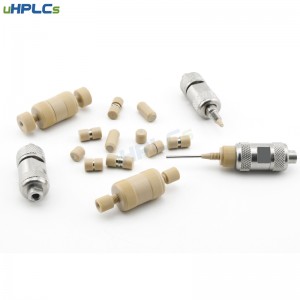Delivering samples to the liquid phase analytical column with a “clean” mobile phase is important for a robust method and high-quality results. Filters are associated with the proper and reliable operation of high-performance liquid chromatography (HPLC) instruments.
Filters and filtration are very important in liquid chromatography because many components in a liquid chromatography system can easily be scrapped lapse if particles are present in the mobile phase flow path. For example, dust or particles in the mobile phase drawn from a solvent bottle can cause the pump check valves to fail partially (leak) or completely (the pump does not produce flow at all). The most obvious failure mode may be a buildup of particulate matter in the feed sample or instrument components at the column inlet, leading to column blockage.
I. Protecting the pump.
The ideal solvent is free of particulate matter from an LC pump perspective. Particulate matter can interfere with the sealing interface between the check valve ball and seat, causing it to leak or fail, resulting in inconsistent or no flow to the pump. Particulate matter also causes faster wear on pump pistons and seals, leading to leaks and inaccurate flow rates. These problems manifest as noise or irregular baselines, unexpected pump-reported operating pressure fluctuations, and retention times variations.
Installing the uHPLCs multi-stage stainless steel inlet solvent filter at the inlet end of the solvent line allows the solvent to be pumped out of the reservoir. Third-order liquid-phase suction filter head: pore size 20um with 3 inner diameter tubes (2mm, 2.5mm, 3mm); First-order liquid-phase suction filter head: pore size 20um with 1/8” tube; First-order liquid-phase suction filter head: pore size 20um with 1/16” tube.

II, filtration costs versus costs due to pump problems.
Using liquid additives and high-quality reagents, thus minimizing the risk of pump-related solvents. In that case, the costs associated with internal filtration may outweigh the pump-related costs of downtime. In that case, the costs associated with internal filtration may outweigh the pump-related costs of downtime. On the other hand, if your lab runs 24/7 and pump stability is critical, you may prioritize internal solvent filtration to maximize instrument uptime.
Risk of chemical and biological contaminants introduced during filtration.
Very high-quality membrane filters are available for filtering LC solvents that are unlikely to contaminate the solvent. However, the filter is only one component of the filtration process. Filters are only one component of the filtration process, so it is essential to properly clean all other parts of the filtration equipment except the filters to avoid introducing particles and chemical contaminants into the filtered solvent. This approach is possible but relies on well-trained operators, standard operating procedures, and a laboratory culture that respects cleanliness. This issue of chemical and biological contaminants is particularly important for methods that focus on trace level determinations because when using very sensitive detectors, the contaminants will be considered noise or interferents.

IV. In-line filters and protective columns
In LC instruments, an in-line filter is usually a filter placed at a point in the mobile phase flow path between the pump outlet and the column inlet. These filters have evolved over the years. The highest performing filters can be used at very high pressures, with small through-hole sizes (down to 0.2 µm) and internal volumes in the microliter range to limit the contribution to peak expansion. The sole purpose of these filters is to collect particles in the mobile phase to prevent these particles from damaging downstream components. Some experimenters do not often use in-line filters immediately after the pump but use them strictly between valves with polymer rotor seals (e.g., autosampler and column switching valves) and analytical columns. Experimenters find that these seals shed large amounts of particles as they wear. Using in-line filters to capture them often extends the life of our analytical columns and small diameter capillary connections.
Replacement filters can cost anywhere from a few dollars to $25, depending on their function. Still, if we can significantly extend the analytical column’s life and improve the instrument’s overall stability, it is easy to replace some of them.
A guard column is essentially a very short version of an analytical column (usually with the same fill material and diameter, but about 5 or 10 mm in length) that screws into the column inlet. One might think that a guard column could also be used as a particle filter to protect the analytical column, but this approach is much more costly (about 10-20% of the purchase price of the column per guard column). Instead, guard columns are better suited for the chemical protection of analytical columns. For example, the guard column can capture sample components that are highly retained by the analytical column, or that would not even be eluted under experimental conditions. After analyzing some samples, we can replace the contaminated guard column with a new guard column for a fraction of the price of a new analytical column.

In this issue of “Troubleshooting LC,” uHPLCs have outlined when and why to filter as much as possible. Of course, in some specific cases, these generalizations do not apply. For example, certain types of detectors, such as light scattering detectors for polymer analysis, are very sensitive to particles in the mobile phase and may require more thorough and consistent filtration of the mobile phase solvent.
Post time: Aug-20-2022






